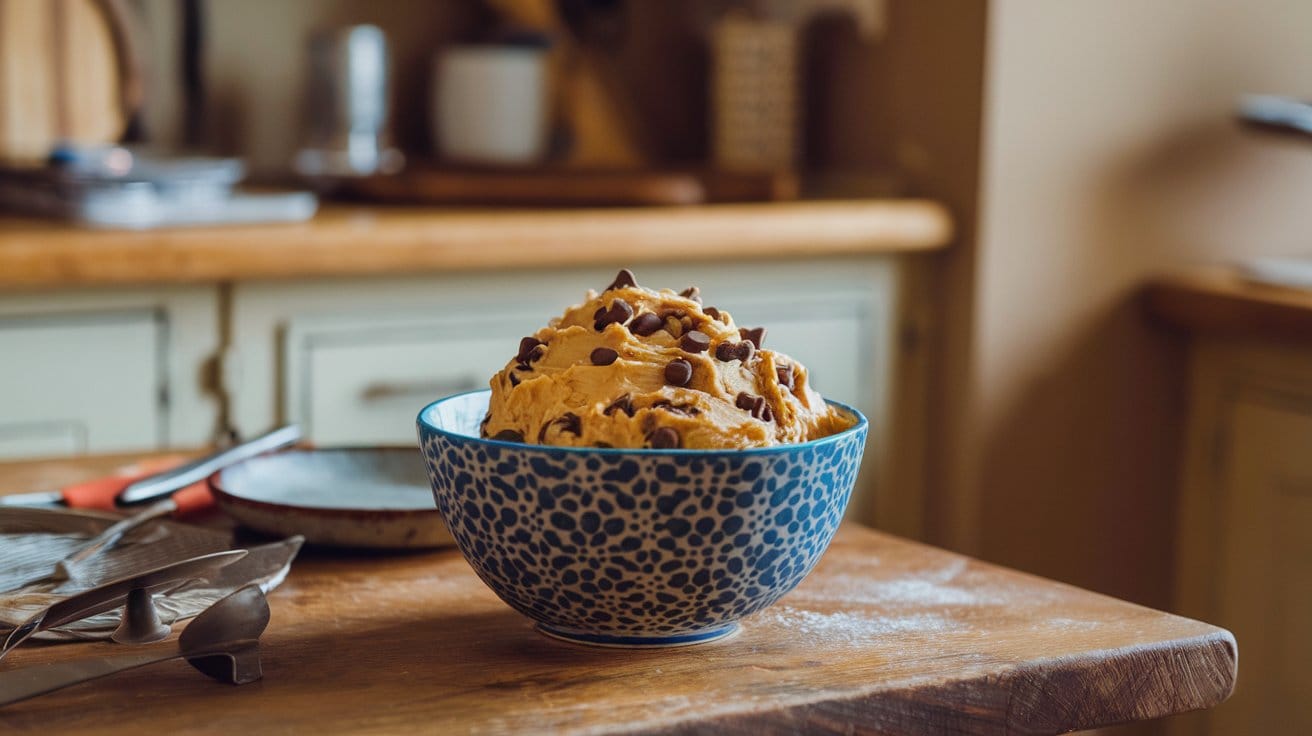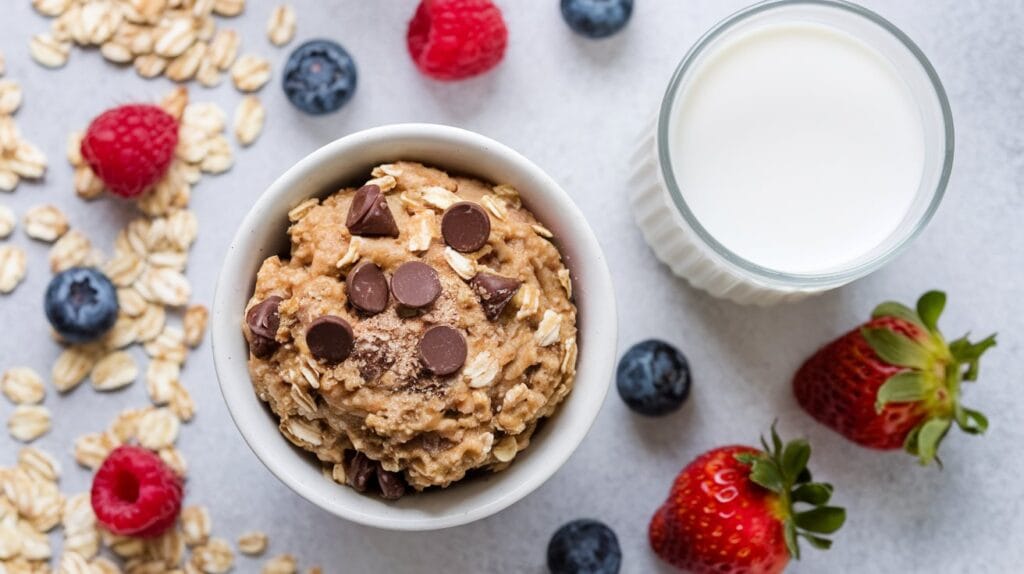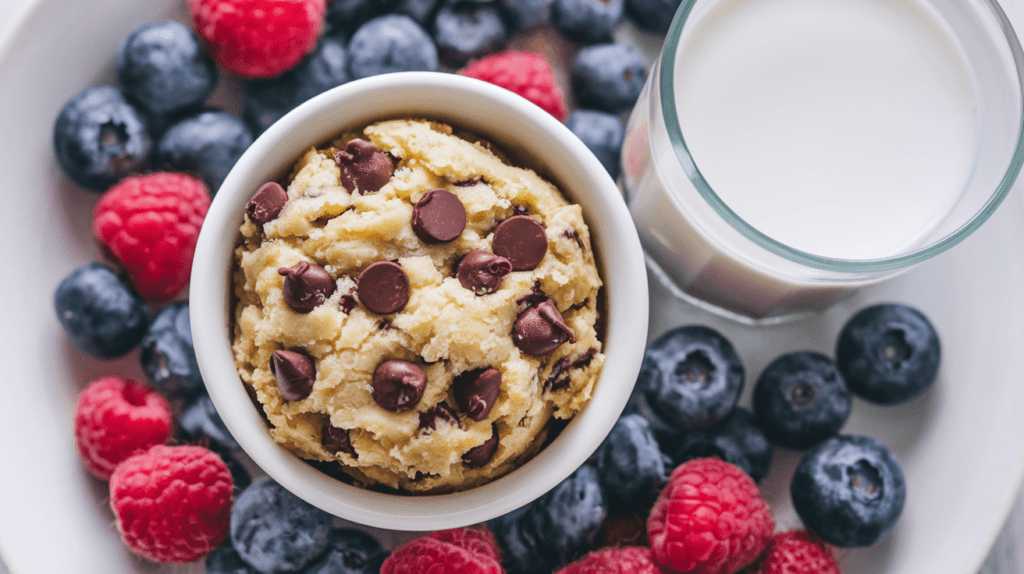Protein Cookie Dough Recipe :
Part 1: Introduction to Protein Cookie Dough
What is Protein Cookie Dough and Why You’ll Love This Recipe?
Protein cookie dough is a nutritious, guilt-free alternative to traditional cookie dough. Unlike the sugary, calorie-packed dough we often crave, this variation is crafted to satisfy your sweet tooth while delivering essential nutrients like protein, fiber, and healthy fats. It’s a no-bake treat that can be eaten raw, offering the same nostalgic experience without the risks of raw egg or uncooked flour.
Imagine a soft, creamy dough you can enjoy straight from the bowl, but instead of just empty calories, you’re fueling your body with high-quality ingredients. Whether you’re a fitness enthusiast, someone watching their macros, or just a dessert lover looking for a healthier option, protein cookie dough has something for everyone.
Benefits of Protein Cookie Dough Recipe for Healthy Snacking
Why switch to protein cookie dough? Let’s dive into its perks:
- High Protein Content: Supports muscle growth and keeps you fuller for longer.
- Low Sugar Options: Helps regulate blood sugar levels and avoids energy crashes.
- Customizable: Tailor flavors, textures, and ingredients to fit your dietary preferences.
- No-Bake Convenience: Skip the oven and whip up a treat in minutes.
- Kid-Friendly: A fun, safe way to introduce children to healthier snacking.
Whether as a pre-workout boost, post-dinner indulgence, or mid-afternoon snack, protein cookie dough fits seamlessly into a balanced lifestyle.
How Protein Cookie Dough Differs from Regular Cookie Dough
Regular cookie dough is indulgent but loaded with butter, sugar, and refined flour. It’s high in empty calories, offers minimal nutritional value, and often includes raw eggs, posing a risk of foodborne illnesses.
Protein cookie dough, on the other hand, is:
- Egg-Free and Safe to Eat Raw.
- Made with protein-rich and nutrient-dense alternatives like protein powder, nut butter, and almond flour.
- A perfect balance of taste and health, making it a guilt-free treat.
Key Ingredients for Protein Cookie Dough
1. Protein Powder: Types and Best Choices
Choosing the right protein powder is crucial for taste and texture. Here are your options:
- Whey Protein: Known for its smooth texture and creamy finish. Best for a classic cookie dough experience.
- Plant-Based Protein: Ideal for vegan or lactose-intolerant individuals. Look for blends with pea or brown rice protein for a balanced profile.
- Casein Protein: Adds thickness and a slightly chewy texture, perfect for dough lovers.
Pro Tip: Stick to flavors like vanilla or chocolate for versatility, or experiment with salted caramel, cookies and cream, or birthday cake protein powder for unique twists.
2. Nut Butter as a Base
Nut butter adds creaminess and healthy fats. Popular options include:
- Peanut Butter: A classic choice for a rich, nutty flavor.
- Almond Butter: Offers a milder, slightly sweet taste.
- Cashew Butter: Ultra-creamy with a naturally sweet profile.
Look for unsweetened, natural nut butters to control sugar content.
3. Sweeteners: Natural vs. Artificial
Balancing sweetness is key. Options include:
- Natural Sweeteners: Maple syrup, honey, or coconut sugar for a subtle, wholesome sweetness.
- Artificial Sweeteners: Monk fruit, stevia, or erythritol for a low-calorie alternative.
Choose based on your dietary goals and flavor preferences.
4. Optional Add-ins for Flavor and Texture
Enhance your cookie dough with these fun additions:
- Chocolate Chips: Use dark or sugar-free options for a healthier twist.
- Chopped Nuts: Almonds, pecans, or walnuts for crunch.
- Dried Fruits: Raisins, cranberries, or chopped dates for natural sweetness.
- Flavor Extracts: Vanilla, almond, or coconut for a deeper flavor profile.
Choosing the Right Protein Powder
1. Whey vs. Plant-Based Protein
- Whey Protein: Great for creaminess and smooth blending. Best for those who tolerate dairy.
- Plant-Based Protein: Often grittier but perfect for vegans. Opt for finely milled options for a smoother texture.
2. Flavor Profiles: Chocolate, Vanilla, and Beyond
- Vanilla Protein Powder: A versatile base that pairs with any add-in.
- Chocolate Protein Powder: Rich and indulgent for chocolate lovers.
- Specialty Flavors: Experiment with unique options like strawberry, pumpkin spice, or chai for seasonal treats.
3. Impact of Protein Type on Texture
The protein type influences the dough’s final texture:
- Whey and casein offer soft, creamy consistency.
- Plant-based powders may require additional liquid or fat to avoid dryness.
Tools Needed for Preparation
1. Basic Kitchen Tools
- Mixing Bowl: For combining ingredients.
- Measuring Cups and Spoons: To ensure accuracy.
- Spatula: For scraping down sides and mixing evenly.
2. Special Equipment for Smoother Mixing
- Electric Mixer: Speeds up the mixing process and ensures a smoother texture.
- Food Processor: Useful for blending harder add-ins like nuts or dried fruits into the dough.
Step-by-Step Instructions
1. Combining the Base Ingredients
- Start with your protein powder, nut butter, and sweetener.
- Mix thoroughly to ensure all dry ingredients are incorporated.
2. Adjusting Consistency
- If the dough feels dry, add a splash of milk or a non-dairy alternative like almond or oat milk.
- If it’s too wet, sprinkle in almond flour or additional protein powder.
3. Incorporating Add-ins
- Gently fold in chocolate chips, nuts, or other add-ins to avoid breaking them.
4. Tips for Mixing Perfectly
- Use room-temperature ingredients for easier blending.
- Mix slowly to prevent overworking the dough, which can lead to toughness.
Part 2: Customizing Your Protein Cookie Dough
Adjusting for Dietary Needs
One of the most versatile aspects of protein cookie dough is its ability to adapt to various diets. Whether you’re keto, vegan, or gluten-free, you can tweak this recipe to meet your needs.
1. Keto-Friendly Modifications
- Protein Powder: Choose a low-carb option like whey isolate or keto-specific blends.
- Sweetener: Use erythritol or stevia to keep the carb count low.
- Flour Substitute: Almond flour is ideal for keto diets as it’s low in carbs and adds a nutty flavor.
- Nut Butter: Stick with unsweetened varieties like almond or macadamia nut butter.
2. Vegan-Friendly Adaptations
- Protein Powder: Opt for plant-based options like pea or brown rice protein.
- Sweeteners: Agave syrup, maple syrup, or coconut sugar for natural sweetness.
- Base Ingredients: Use cashew butter or sunflower seed butter for a creamy texture.
3. Gluten-Free Options
Most protein cookie dough recipes are inherently gluten-free when using almond flour or coconut flour. However, always check labels to ensure there’s no cross-contamination.
Flavor Variations
1. Peanut Butter Bliss
- Combine chocolate protein powder with peanut butter for a classic combo.
- Add chopped peanuts for extra crunch.
2. Chocolate Chip Dream
- Use vanilla protein powder as a base.
- Stir in sugar-free chocolate chips for a traditional cookie dough experience.
3. Birthday Cake Fun
- Start with vanilla protein powder.
- Add rainbow sprinkles and a touch of almond extract for a festive twist.
4. Cinnamon Roll Delight
- Incorporate cinnamon protein powder or vanilla with a pinch of ground cinnamon.
- Add a drizzle of sugar-free icing for indulgence.
The possibilities are endless—experiment with flavors and textures to keep your protein cookie dough exciting.
Storage and Shelf Life
Proper storage ensures your protein cookie dough stays fresh and safe to eat. Here’s how to store it effectively:
1. Refrigeration Tips
- Store the dough in an airtight container to retain moisture.
- Keep in the fridge for up to 7 days.
- Let it sit at room temperature for a few minutes before eating for a softer texture.
2. Freezing for Longer Storage
- Portion the dough into individual servings.
- Wrap tightly in plastic wrap or store in a freezer-safe container.
- Freeze for up to 3 months. Thaw in the fridge overnight before enjoying.
check out this also this hot fudge brownie bread
Benefits of Protein Cookie Dough
1. High Protein Content for Muscle Building
- Protein supports muscle repair and growth, making this snack ideal for fitness enthusiasts.
- Combine whey or plant-based protein with nut butter to enhance the amino acid profile.
2. Low Sugar Options for Balanced Blood Sugar
- Using natural or sugar-free sweeteners keeps your cookie dough diabetic-friendly.
- Avoid the spikes and crashes associated with traditional desserts.
3. Nutritional Value vs. Regular Desserts
Protein cookie dough outshines regular cookie dough with:
- Higher protein content.
- Reduced sugar levels.
- Inclusion of healthy fats from nut butters.
It’s a dessert that satisfies cravings while fueling your body.
Serving Ideas
1. Enjoying Protein Cookie Dough as a Snack
- Eat it straight from the bowl with a spoon for instant satisfaction.
- Pair with a cup of coffee or tea for a mid-day treat.
2. Using It as a Topping
- Yogurt Bowls: Add a dollop to Greek yogurt for a protein-packed breakfast.
- Smoothies: Blend chunks of cookie dough into your smoothie for added texture.
- Oatmeal: Stir into warm oats for a delicious twist.
Common Mistakes and Fixes
Even seasoned bakers can face challenges when making protein cookie dough. Here’s how to troubleshoot common issues:
1. Overpowering Protein Taste
- Use flavored protein powders like chocolate or vanilla to mask the strong aftertaste.
- Balance with natural sweeteners and vanilla extract.
2. Dry or Crumbly Dough
- Add liquid gradually, such as almond milk or water, to reach the desired consistency.
- Ensure nut butter is fresh and creamy to prevent dryness.
3. Achieving a Balanced Flavor
- Taste as you go! Adjust sweetness, saltiness, or extract levels to suit your preference.
Part 3: Frequently Asked Questions (FAQs) About Protein Cookie Dough
1. Can You Bake Protein Cookie Dough?
Yes, you can bake protein cookie dough, but the results may vary depending on the recipe. Since it lacks some traditional cookie ingredients like eggs and baking soda, the texture will differ. For baking:
- Add a teaspoon of baking powder for a fluffier consistency.
- Bake at 350°F (175°C) for 10–12 minutes or until slightly golden.
2. Is It Safe to Eat Raw?
Absolutely! Protein cookie dough is specifically designed to be eaten raw because it doesn’t contain raw eggs or untreated flour. Ingredients like almond flour and protein powder are safe and don’t carry the risks of traditional cookie dough.
3. How to Calculate Macros for a Batch?
To calculate macros:
- Total up the calories, protein, carbs, and fats of each ingredient in your recipe.
- Divide by the number of servings you plan to make.
For precise tracking, use apps like MyFitnessPal to input ingredient quantities.
4. What’s the Best Protein Powder for Cookie Dough?
Whey isolate and plant-based protein powders with smooth textures are ideal. Flavored options like chocolate or vanilla enhance the taste without overpowering the recipe. Avoid overly gritty or unflavored powders unless you plan to add extra sweeteners.
5. How Long Does Protein Cookie Dough Last?
- Refrigerated: Stays fresh for up to 7 days in an airtight container.
- Frozen: Maintains quality for 2–3 months when stored properly.
6. Can Kids Eat Protein Cookie Dough?
Yes! Protein cookie dough is kid-friendly, especially when using natural sweeteners and mild-flavored protein powders. It’s a great way to introduce healthier snacks without them feeling like they’re “missing out.”
7. What’s the Difference Between Homemade and Store-Bought Protein Cookie Dough?
Homemade protein cookie dough offers:
- Ingredient Transparency: Control over what goes in, ensuring no artificial additives.
- Cost Savings: Making it at home is often cheaper than buying pre-packaged options.
- Customizability: You can adjust flavors, textures, and macros to your liking.
8. Can You Make It Nut-Free?
Yes! Substitute nut butter with seed-based options like sunflower seed butter. Ensure other ingredients, such as chocolate chips, are labeled nut-free to avoid cross-contamination.
9. How Can You Reduce the Sweetness?
If the dough is too sweet:
- Use unflavored protein powder instead of sweetened varieties.
- Replace sugary add-ins like chocolate chips with nuts or seeds.
- Cut back on sweeteners like maple syrup or honey and add vanilla or almond extract for a subtler flavor.
10. What’s the Ideal Consistency for Protein Cookie Dough?
The dough should be soft and pliable but firm enough to hold its shape. If it’s too wet or sticky, add almond flour or protein powder. For dry dough, incorporate more liquid like almond milk or a touch of melted nut butter.
Comparison with Store-Bought Options
1. Cost Differences
Homemade protein cookie dough is significantly cheaper. With store-bought options, you’re paying a premium for packaging and marketing. By making it yourself, you can use bulk ingredients and save money.
2. Ingredient Transparency
Store-bought protein cookie dough often contains preservatives and artificial ingredients to extend shelf life. Homemade versions allow you to prioritize:
- Natural Ingredients: No artificial flavors or colors.
- Dietary Restrictions: Customization for allergies or intolerances.
3. Taste and Texture
Homemade dough often tastes fresher and has a more authentic texture, as you can adjust the ingredients to your liking. Store-bought options may be overly sweet or gritty.
Nutritional Profile Breakdown
1. Caloric Content
Protein cookie dough is generally lower in calories than regular cookie dough, depending on sweeteners and add-ins. A typical serving contains:
- Calories: 150–200
- Protein: 10–15g
- Carbs: 10–15g
- Fats: 7–10g
2. Protein vs. Carb Ratio
High-protein dough usually has a favorable protein-to-carb ratio, making it ideal for fitness-focused individuals or those on low-carb diets.
3. Fat Content
The fat content comes primarily from nut butters, which provide healthy fats essential for energy and satiety.
Environmental Impact
1. Reducing Food Waste with DIY Recipes
Homemade protein cookie dough helps minimize waste by allowing you to use pantry staples and avoid excess packaging. Bulk purchases of protein powder, nut butter, and flour further reduce your carbon footprint.
2. Eco-Friendly Ingredient Sourcing
Choose sustainably sourced ingredients to make your recipe more eco-friendly:
- Nut Butters: Opt for brands that use organic and sustainably grown nuts.
- Sweeteners: Look for fair-trade options like organic coconut sugar or honey.
Fun Ways to Share Protein Cookie Dough
1. Gifting Ideas
Pack your dough in small mason jars with a decorative ribbon and a personalized tag. Include the recipe for a thoughtful, health-conscious gift.
2. Hosting a Healthy Dessert Party
Create a DIY protein cookie dough bar. Provide various mix-ins like chocolate chips, dried fruits, and nuts, allowing guests to customize their creations.
3. Making Protein Cookie Dough with Kids
Kids love getting involved in the kitchen. Let them:
- Choose their favorite mix-ins.
- Shape the dough into fun bite-sized balls.
- Decorate with sprinkles or mini chocolate chips.
It’s an excellent opportunity to teach healthy eating habits in a fun and engaging way.
Conclusion: Enjoying Protein Cookie Dough
Protein cookie dough is more than a snack—it’s a versatile, customizable, and nutritious option for dessert lovers of all ages. Whether you’re experimenting with flavors, sharing with friends, or indulging solo, this recipe is the perfect blend of health and indulgence.
check out this also this hot fudge brownie bread



